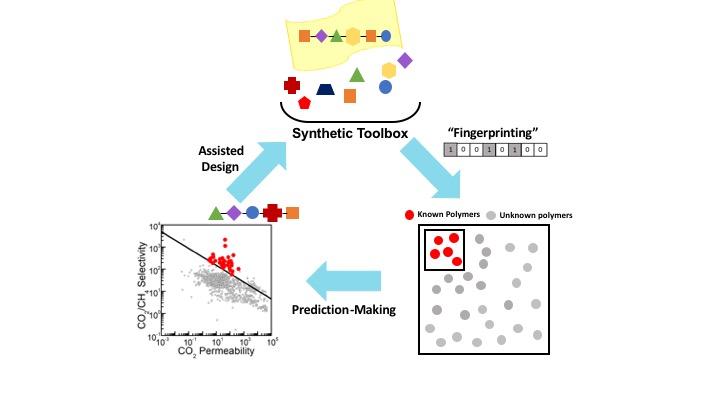Columbia engineers apply machine learning techniques to narrow down and speed up the development of new materials for removing CO2 from the air

Credit: Connor Bilchak/Columbia Engineering
New York, NY–May 15, 2020–Researchers at Columbia Engineering and the University of South Carolina have developed a method that combines big data and machine learning to selectively design gas-filtering polymer membranes to reduce greenhouse gas emissions.
Their study, published today in Science Advances, is the first to apply an experimentally validated machine learning method to rapidly design and develop advanced gas separation membranes.
“Our work points to a new way of materials design and we expect it to revolutionize the field,” says the study’s PI Sanat Kumar, Bykhovsky Professor of Chemical Engineering and a pioneer in developing polymer nanocomposites with improved properties.
Plastic films or membranes are often used to separate mixtures of simple gases, like carbon dioxide (CO2), nitrogen (N2), and methane (CH4). Scientists have proposed using membrane technology to separate CO2 from other gases for natural gas purification and carbon capture, but there are potentially hundreds of thousands of plastics that can be produced with our current synthetic toolbox, all of which vary in their chemical structure. Manufacturing and testing all of these materials is an expensive and time-consuming process, and to date, only about 1,000 have been evaluated as gas separation membranes.
Kumar and his collaborators at Columbia Engineering, the University of South Carolina, and the Max Planck Society in Mainz (Germany) created a machine learning algorithm that correlates the chemical structure of the 1,000 tested polymers with their gas transport properties, to investigate what structure makes the best membrane. They then applied the algorithm to more than 10,000 known polymers to predict which would produce the best material in this context.
This procedure identified some 100 polymers that had never been tested for gas transport but were predicted to surpass the current membrane performance limits for CO2/CH4 separations.
“Rather than experimentally test all the materials that exist for a particular application, you instead test a smaller subset of materials which have the most promise. You then find the materials that combine the very best ingredients and that gives you a shot at designing a better material, just like Netflix finding you the next movie to watch”, says the study’s co-author Connor Bilchak, formerly a PhD student with Kumar and currently a post-doctoral fellow at the University of Pennsylvania.
To test the algorithm’s accuracy, a group led by Brian Benicewicz, SmartState Professor of Chemistry and Biochemistry at the University of South Carolina, synthesized two of the most promising polymer membranes predicted by this approach and found that the membranes exceeded the upper bound for CO2/CH4 separation performance.
“Their performance was very good ? much better than what had been previously made,” says the study’s co-author Laura Murdock, a graduate student of Benicewicz’s. “And it was pretty easy. This methodology has significant potential for commercial use.”
Benicewicz added, “Looking beyond this one context, this method is easily extendable to other membrane materials which could profoundly affect the development of next generation batteries and technologies for water purification.”
###
About the Study
The study is titled: “Designing exceptional gas-separation polymer membranes using machine learning.”
Authors are: J. Wesley Barnett1, Connor R. Bilchak1, Yiwen Wang1, Brian C. Benicewicz2, Laura A. Murdock2, Tristan Bereau3, Sanat K. Kumar1
1 Department of Chemical Engineering, Columbia Engineering
2 Department of Chemistry and Biochemistry, University of South Carolina
3 Max Planck Institute for Polymer Research, Germany.
The study was supported by the NSF Graduate Research Fellowship Program (grant DGE-16-44869 to C.R.B.), the DMREF Program (grant 1629502 to C.R.B., J.W.B., and S.K.K. and grant 1629052 to B.C.B. and L.A.M.), and the Emmy Noether Program of the Deutsche Forschungsgemeinschaft (to T.B.). S.K.K., J.W.B., and C.R.B. acknowledge that the majority of the work was funded by NSF through DMREF grant CTS-1629502. This project was started under a previous NSF grant (DMR-150730), which was continued as grant DMR-1929655.
The authors declare no financial or other conflicts of interest.
LINKS:
Paper: https:/
DOI: 10.1126/sciadv.aaz4301
https:/
http://engineering.
https:/
https:/
https:/
http://www.
https:/
Columbia Engineering
Columbia Engineering, based in New York City, is one of the top engineering schools in the U.S. and one of the oldest in the nation. Also known as The Fu Foundation School of Engineering and Applied Science, the School expands knowledge and advances technology through the pioneering research of its more than 220 faculty, while educating undergraduate and graduate students in a collaborative environment to become leaders informed by a firm foundation in engineering. The School’s faculty are at the center of the University’s cross-disciplinary research, contributing to the Data Science Institute, Earth Institute, Zuckerman Mind Brain Behavior Institute, Precision Medicine Initiative, and the Columbia Nano Initiative. Guided by its strategic vision, “Columbia Engineering for Humanity,” the School aims to translate ideas into innovations that foster a sustainable, healthy, secure, connected, and creative humanity.
Media Contact
Holly Evarts
[email protected]
Related Journal Article
http://dx.




